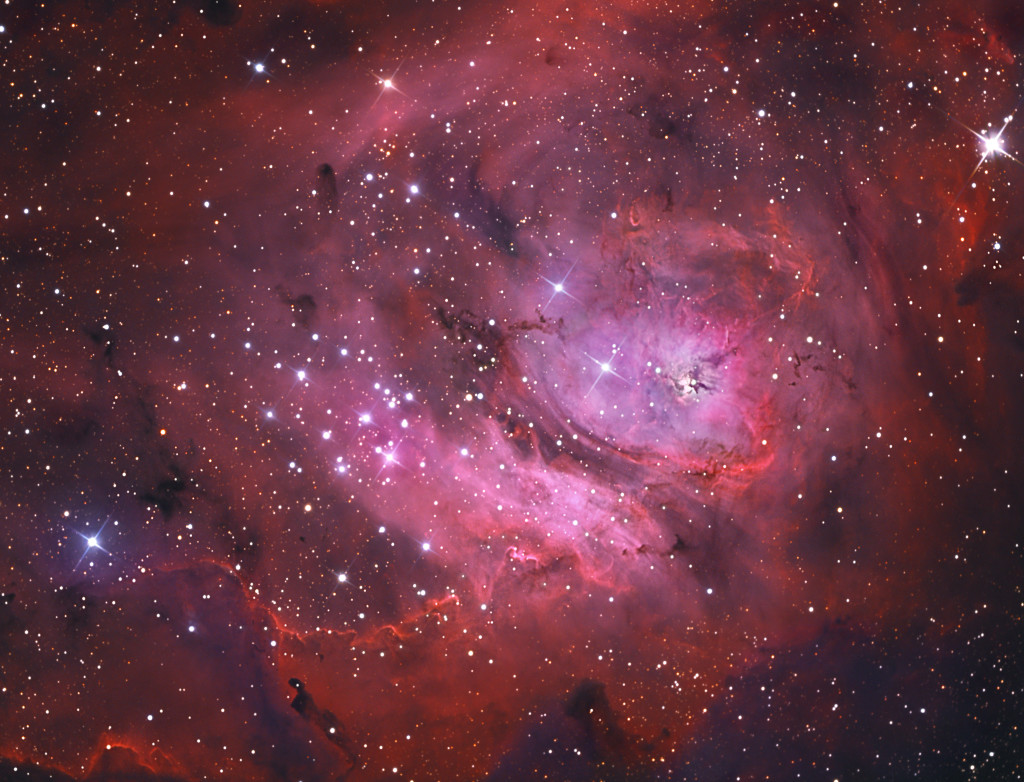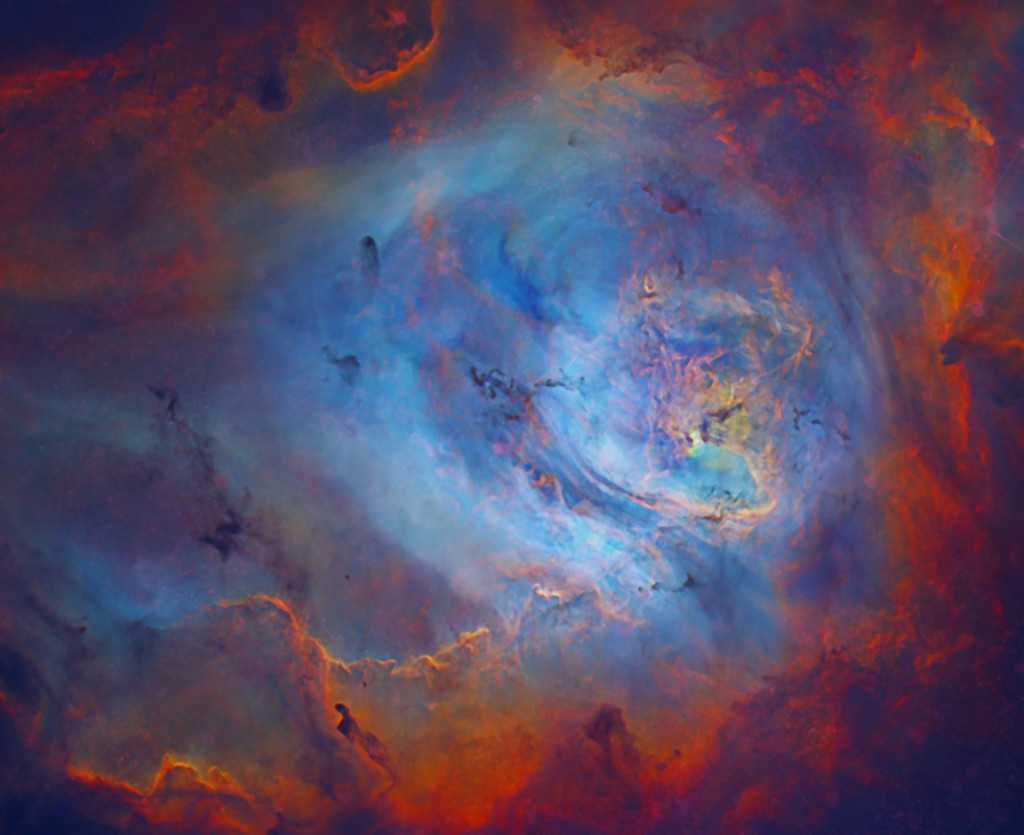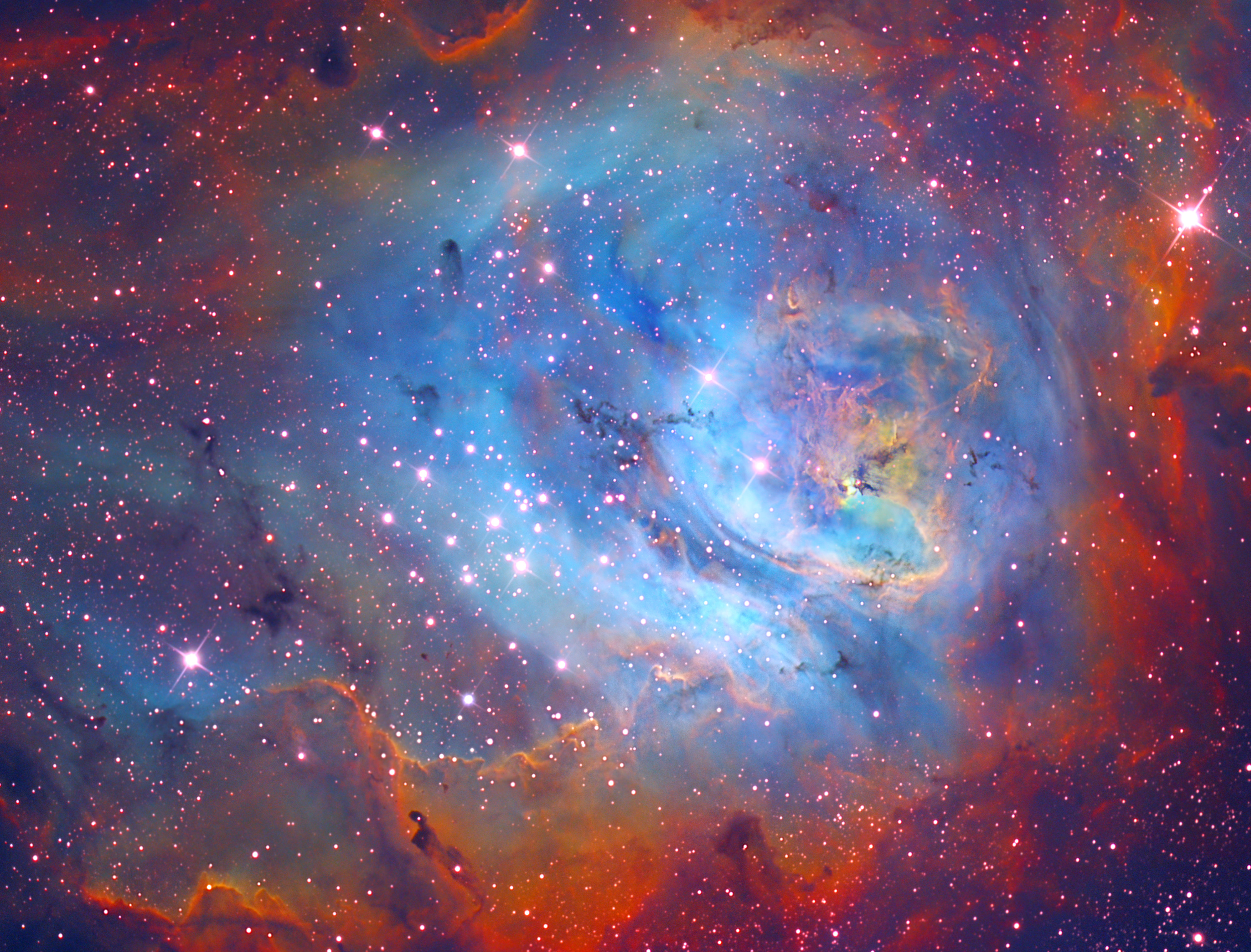




After an Orion Nebula narrowband (NB) effort, I promised to lead an emission-line imaging assault on the Lagoon Nebula (M8) in the summer Milky Way. So, during the July (2010) new Moon at the Chiefland Astronomy Village, multiple 1X1 subframes of M8 were recorded with the 14.5-inch RCOS at f/9 using 5nm bandpass SII, Ha and OIII Astrodon filters in the Apogee U16M camera at minus 20C on a 75F night. Sulfur II (SII) was the weakest signal so I went 100 minutes total compared to 40 minutes total each for the hydrogen-alpha (Ha) and oxygen III (OIII) subexposures. I made sure the subframes did not burn out the bright interior Hourglass region in these exposures. I additionally used 30 minutes of luminance data (from April 2010 CAV Expedition) 1X1 for detail and contrast support; I could have used Ha for luminance, but didn’t. I chose the Hubble Palette to map the narrowband data to red (SII), green (Ha) and blue (OIII) and created an LR(SII)G(HA)B(OIII) M8 image. The ratio of R:G:B in Maxim for a starting point was 4 / 0.5 / 3. I attached several images including a very stretched, deep version. It was tricky maintaining the hourglass region but managed to do so with layer masks (paint-throughs). This image shows the rust-colored SII/Ha not only on the peripheral margins of M8 but also associated with the hourglass region! The interior near the Hourglass and cluster is hottest and is dominated by OIII/Ha, although SII tendrils emanate from the Hourglass, presumably towards us.
A second less aggressively-processed “muted” image shows the subtle green hydrogen-alpha and blue oxygen III coloration in the brighter hotter regions of M8. Additionally, a small bright peculiar red spot is seen below center on this muted image; this is the only truly RED object identified on this image. This object could only be appreciated in the SII subexposures and not at all in the H-alpha or OIII exposures (hence the genuine red color in the LRGB)! When I saw this red spot, I wondered if this was an undiscovered Herbig-Haro protostar object peering out of the molecular cloud invisible in shorter wavelengths. Why did that occur to me, you ask? A few weeks ago, I read an article by Arias et. al. “Pre-Main Sequence Stars in the Lagoon Nebula” in 2003 Mon. Not. R Astron. Soc. They found 37 new Herbig-Haro objects in the Lagoon Nebula, so I wondered if this could be one of those! But re-reading that article today revealed none of them matched the red spot on my Lagoon NB image. Curious, I did more research using a Google search for other articles by Dr. Arias and (unfortunately) found that the peculiar red spot nebula was just discovered two years ago by Dr. Arias et. al. using SII and Ha filters (no surprise) on a monster ESO telescope at La Silla, Chile (link below)! The red spot is actually Herbig-Haro object HH 893 (bi-lobed at their scale) and is described in Dr. Arias’ article “Geysers in the Lagoon: New Herbig-Haro Objects in M8” in Astronomy & Astrophysics, Feb. 1, 2008. In this 2008 article (link below), they describe 5 new HH objects (see attached charts from article) including “my” red spot. The object is so obvious on my Chiefland RC image that I can’t help wondering if this HH object is showing a new outburst of jet activity making it more visible!
Also pictured is a mosaic comparing the Hubble Space Telescope image of the Hourglass region (link below) including cool “interstellar twisters” to an enlarged version of my NB M8 image. It is very surprising to me just how close the color match is between my NB image and the HST NB image; kudos go the Astrodon for the filters. The Lagoon Nebula only rises to a maximum altitude of 36 degrees on the meridian at CAV and many of these subframes were captured below 2 atmospheres elevation!
http://arxiv.org/PS_cache/arxiv/pdf/0706/0706.2378v1.pdf – Discovery article on HH 893 (2008)!!!
http://arxiv.org/PS_cache/astro-ph/pdf/0611/0611150v1.pdf – Article about pre-main sequence stars in M8 (2003).
http://www.rc-astro.com/photo/id1170.html – Awesome starless NB M8 taken 2006.
When the summer of ’68 arrived and I saw the Lagoon Nebula for the first time, I wondered if the star cluster NGC 6530, in the eastern half of the nebula, was the sole illumination source for the whole complex. However, I noticed that the western half of the nebula was far brighter with no cluster. What illuminates the brighter area opposite the cluster? Does the Lagoon Nebula have a dominant illumination “point” source like the Orion Nebula has the Trapezium? If so, where is it??
This same question was raised six years earlier (1961) by Fulbright scholar N. J. Woolf (now head of NASA’s astrobiology unit at U. Arizona) who focused attention and Lick telescopes on one unassuming 9.5 magnitude star candidate named Herschel 36 (Her 36) (link below) as a dominant energy source for the entire complex. His study characterized Her 36 as a intrinsically very luminescent but severely obscured star just 10 arcsec west of the bright Hourglass asterism (brightest part of M8). Numerous subsequent papers over the half-century support the concept of a few super-luminous spectral type massive O protostars (9 Sag and Her 36) being dominant illuminators of M8. Turns out that the Orion and Lagoon Nebulae have a lot more in common than I imagined. Each has a few dominating O & B stars that actually appear to be multiple systems (binaries, triplets, more). In the case of M42 , theta-1 within the Trapezium, seems to be multiple (links below). In M8, “star” Her 36 may actually also be a multiple star system much like theta-1 Orionis. Her 36 appears as only magnitude 9.5 and white instead of bright, dazzling blue (as spectral class 07V would imply) apparently because of a “peculiar extinction” and reddening caused by dense graphite and silicate dust (see link 3) which has also recently been identified around theta-1 in M42! And to top it all off, there appears to be a jet emanating from Her 36, a finding not yet identified in the Orion system (as far as I know). I’ll never look at M8 in quite such a “pedestrian” way again.
http://articles.adsabs.harvard.edu/full/1961PASP…73..206W — Woolf’s original 1961 article about star Her 36
http://articles.adsabs.harvard.edu/cgi-bin/nph-iarticle_query?1995ApJ…445L.153S&defaultprint=YES&page_ind=0&filetype=.pdf – Jet emanating from “central star” Her 36!
http://adsabs.harvard.edu/full/1982ApJ…263L..39H – peculiar extinction of Her 36 Trapezium-like!
http://arxiv.org/PS_cache/arxiv/pdf/1001/1001.3892v1.pdf – Multiplicity of Her 36 similar to theta-1 in trapezium in M42!!
http://www.aanda.org/index.php?option=com_article&access=standard&Itemid=129&url=/articles/aa/full_html/2010/06/aa13992-10/aa13992-10.html —- Theta-1 a multi-star system in M42!!








